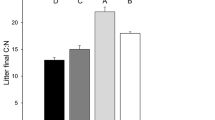Summary
-
1)
In terrestrial isopods total copper concentration increases exponentially with size, the exponentb in the equationy=a·x b being larger in populations rich in copper than in populations poor in copper.
-
2)
However, immediately after hatching all species so far tested in Tirol contain the same amount, i.e., approximately 0.13 μg Cu per mg dry weight.
-
3)
A very close correlation (r=0.98) exists between the mean copper concentrations of isopods and litter, from a series of habitats ranging widely in their copper content. The correlation with the copper concentration of the soil is much less clearly expressed.
-
4)
In isopods kept in culture and fed litter from their original habitats the concentration of copper increases. This increase is almost entirely due to an elevation of the copper content of the hepatopancreas.
-
5)
Feeding a low-copper diet to a high-copper population for four weeks did not alter significantly the mean copper concentration of the animals.
-
6)
There is a marked temperature-dependent seasonal fluctuation in the copper content of isopods, with a maximum in winter and a minium in summer.
-
7)
On the basis of dry weight the concentration factor for copper is about six, the same as that for cadmium in another species of isopod studied by Martin et al. (1976) in England, and much higher than the concentration factors for the same metals by pulmonate snails.
Similar content being viewed by others
References
Boyden, C.R.: Trace element content and body size in molluscs. Nature (Lond.)251, 311–314 (1974)
Coughtrey, P.J., Martin, M.H.: The uptake of lead, zinc, cadmium and copper by the pulmonate mollusc,Helix aspersa Muller, and its relevance to the monitoring of heavy metal contamination of the environment. Oecologia (Berl.)27, 65–74 (1977)
Dallinger, R.: The flow of copper through a terrestrial food chain. III. Selection of an optimum copper diet by isopods. Oecologia (Berl.)30, 273–276 (1977)
Dallinger, R., Wieser, W.: The flow of copper through a terrestrial food chain. I. Copper and nutrition in isopods. Oecologia (Berl.)30, 253–264 (1977)
Martin, M.H., Coughtrey, P.J., Young, E.W.: Observations on the availability of lead, zinc, cadmium and copper in woodland litter and the uptake of lead, zinc and cadmium by the woodlouse,Oniscus asellus. Chemosphere5, 313–318 (1976)
Wieser, W., Wiest, L.: Ökologische Aspekte des Kupferstoffwechsels terrestrischer Isopoden. Oecologia (Berl.)1, 38–48 (1968)
Wieser, W.: Untersuchungen über die Ernährung und den Gesamtstoffwechsel vonPorcellio scaber (Crustacea: Isopoda). Pedobiol.5, 304–331 (1965)
Wieser, W., Busch, G., Büchel, L.: Isopods as indicators of the copper content of soil and litter Oecologia (Berl.)23, 107–114 (1976)
Author information
Authors and Affiliations
Additional information
Supported by the “Fonds zur Förderung der wissenschaftlichen Forschung in Österreich”, project no. 2851
Rights and permissions
About this article
Cite this article
Wieser, W., Dallinger, R. & Busch, G. The flow of copper through a terrestrial food chain. Oecologia 30, 265–272 (1977). https://doi.org/10.1007/BF01833633
Received:
Issue Date:
DOI: https://doi.org/10.1007/BF01833633




